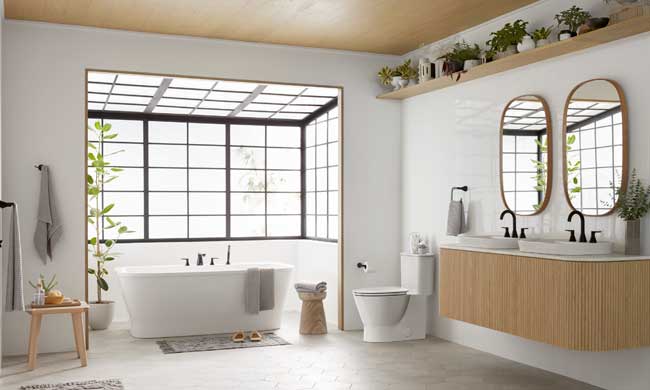Live Better
Breathe easier at home

Improve Your Home’s Air Quality
(Family Features) The COVID-19 pandemic continues to change the way people spend time in their homes. From work to working out, more out-of-the-house activities have moved to the home.
In fact, according to the 2021 American Time Use Survey, 38% of employed people did some or all of their work from home. That means better indoor air quality at home is as important as ever.
According to the Environmental Protection Agency, indoor air quality can be up to five times worse than outdoor air quality. With the average person taking about 22,000 breaths per day, installing smarter indoor air quality technology is key to healthier living year-round.
Improving your home’s air quality begins with recognizing what contributes to poor indoor air quality, the potentially harmful effects and how to address these problems.
Off-gassing
Off-gassing from construction materials, carpeting, adhesives and synthetic materials, as well as solvents from common household cleaners, can accumulate in even well-constructed homes. Continuous ventilation solutions can help reduce the harmful effects of off-gassing, such as headaches, nausea and irritation in your eyes, nose and throat.
Simple smart ventilation fans and good ventilation can help control off-gassing in your home. Other options for reducing the impact of off-gassing include shopping for products designed for low or no volatile organic compound emission and adding houseplants that naturally help filter and purify the air, though houseplants only offer a small amount of help.
Moisture
Moisture that is not properly ventilated can cause mildew and mold formation, which can potentially lead to structural problems and health issues. For most homes, the optimal humidity balance is 40-60%, but those levels can be hard to maintain in high-humidity spaces like bathrooms.
Antimicrobial light technology combined with powerful ventilation offers effective protection against bacteria, mold and fungi growth in your home. An option like the Broan SurfaceShield LED Exhaust Fan kills viruses and prevents mold, bacteria and fungi growth on surfaces in your bathroom or other humidity-prone environments. Featuring two lighting modes, an everyday white light perfect for task lighting and a continuous antimicrobial mode, the cover is also designed to stay cleaner longer with less louvers in which dust and dirt can get trapped.
Cooking effluents
Cooking effluents from food preparation can infiltrate the whole house in minutes. Grease, oils and aromas settle permanently into carpet, furniture, clothing and other surfaces. Kitchen ventilation solutions can help eliminate cooking effluents for a cleaner, more comfortable and healthier environment.
For example, the Broan Elite 21-Inch Custom Range Hood Power Pack offers a custom appearance while protecting cabinetry with stainless steel liners. Bright LED lighting enhances your cooking experience while the four-speed, back-lit, soft touch control and WiFi connectivity enabling voice control makes operating the hood easy. Automatic infrared sensing allows your range hood to adjust the speed of your fan based on your cooking style.
Pollutants
Stemming from sources like space heaters, gas stoves, woodstoves, indoor furnaces, dryers and fireplaces, combustion pollutants are gases or particles that come from burning materials. Examples include carbon monoxide – causing headaches, dizziness, disorientation, nausea and fatigue – and nitrogen dioxide – causing eye, nose and throat irritation; impaired lung function; and increased respiratory infections.
When possible use appliances that vent to the outside, ventilate rooms where fuel-burning appliances are in use and ensure these appliances are properly installed, used, adjusted and maintained.
Explore more ideas for improving air quality in your home at broan-nutone.com.
Common Household Air Offenders
Understanding and controlling some of the common pollutants found in homes, schools and offices may help improve your indoor air and reduce your family’s risk of health concerns related to indoor air quality.
Radon, a radioactive gas that forms in soil, enters your home by seeping through cracks and gaps in floors and walls touching the ground.
Secondhand smoke comes from burning tobacco products.
Combustion pollutants are created when certain materials are burned in appliances that are poorly vented, such as space heaters, stoves, water heaters, dryers and fireplaces. Common examples are carbon monoxide and nitrogen dioxide, which are both colorless, odorless gasses that can be difficult to identify.
Volatile organic compounds can be found in numerous household products like paints and lacquers, paint strippers, cleaning supplies, varnishes and waxes, pesticides, building materials and furnishings, office equipment, moth repellents, air fresheners and dry-cleaned clothing.
Asthma triggers vary depending on the person and what causes their asthma to flare, but common examples include mold, dust mites, secondhand smoke and pet dander, as well as certain foods and air pollutants.
Molds are living organisms that produce spores, which transfer through the air before resting on damp surfaces and growing.
Photo courtesy of Getty Images (couple on couch)
SOURCE:
Broan-NuTone
Live Better
This Mother’s Day, give the gift of giving back

(Family Features) Celebrate Mom and other special women in your life with a Mother’s Day gift that makes a lasting impact for children.
When you shop at UNICEF Market, you’re not only choosing beautifully hand-crafted artisanal gifts, but also supporting its efforts to keep children healthy, educated and safe across 190 countries and territories. A portion of every sale could provide safe water, enhance schools, supply essential services or protect infants from preventable diseases.
Each item, from jewelry and apparel to homeware, is sourced from talented artisans who receive fair prices for their creations, strengthening their communities and supporting their families. In fact, the gifts give back three times over: They support artisans and help communities thrive, assist vulnerable children and make for thoughtful, compassionate Mother’s Day gifts.
Choose a meaningful gift that honors the special women in your life while empowering children with the tools for a better future.
Featured Gifts
- Aqua Handblown Recycled Glass Carafe and Cup Set, ‘Delicate Aqua’
Add a touch of elegance to any space with this eco-friendly carafe and glass set, handblown from recycled glass by artisans in Mexico. Perfect for your home office or bedside table, it’s a beautiful and practical way to support sustainability.
- Handmade Artisan Jewelry
Choose from a stunning collection of handmade jewelry crafted by artisans from around the world, including first-edition Beads of Hope Bracelets from Guatemala. From modern designs to timeless elegance, each piece tells a story of cultural heritage and artistry.
- Unique Home Decor
Bring a global touch to your home with handcrafted decor from Africa, Latin America and Asia. Whether it’s a rustic accent, a Peruvian rug or an African sculpture, these pieces can add character and charm to any room.
Inspired Gifts for Moms and Babies
For a gift that truly gives back, consider UNICEF’s Inspired Gifts. These donations support life-saving programs and can be sent via email or printed as a card. Perfect for those who have it all, these gifts honor the special women in your life while supporting children across the globe.
- Mom and Baby Care
Ensure the safety and well-being of both mother and baby with a package that includes essential medications for a smooth and safe delivery. This gift directly supports the health of moms and babies in need. - Bundle of Hope
Your donation can provide children with the essential tools for learning and growing: clean water, soap, exercise books, pencils, vaccines and therapeutic food. This gift helps ensure all children have the resources they need for healthy, productive futures.
This Mother’s Day, celebrate moms and children around the world with a gift that keeps on giving by visiting market.unicefusa.org.
SOURCE:
Live Better
Big upgrades for small spaces: Bathroom reno for style, function

(Family Features) Home renovations happen for a variety of reasons – whether to reflect personal style preferences, replace worn out materials or adapt to a family’s evolving functional needs. Among the most popular upgrades homeowners tackle, bathroom renovations can be a smart and worthwhile investment.
Updating a bathroom, even a small one, requires careful planning to ensure both aesthetic appeal and long-term functionality. To maximize the value of your investment, focus on a design that is timeless and products that offer a blend of beauty, comfort and performance.
“As a designer and renovator, I know firsthand the impact fixtures can have on a home,” said Keith Bynum, home renovation expert, designer and HGTV star. “American Standard has been my go-to for renovation projects because their products are built to last, beautiful and timeless. The brand’s approach aligns with my own – creating stylish, convenient spaces with high-quality products that cater to real-life needs and improve the way we live.”
Discover these expert tips for selecting the perfect products for your bathroom upgrade from American Standard, a trusted leader in bathroom and kitchen plumbing fixtures that is celebrating 150 years of designing innovative products that are truly “built for life.”
Sinks
Your sink should not only enhance the visual appeal of your bathroom but also meet your practical, everyday needs. Striking the right balance between aesthetics and practicality is essential when choosing the perfect sink for your space. If you’ve never shopped for a sink before, you may not realize how many styles there are to choose from.
An undermount sink sits with its edge below the level of the countertop, creating a seamless surface that makes it easier to clean while hiding from view. A drop-in sink is placed into an opening with the rim creating a lip that forms a barrier between your sink and counter. A vessel sink resembles a standalone basin, often used as a decorative and contemporary alternative to traditional sinks in powder rooms. The sleek and clean design of a pedestal sink makes it a perfect solution for smaller spaces, although additional storage may be needed.
Once you decide on the sink, you’ll also need to determine what furniture to pair with it. Some popular options to complete the look and enhance usability include a console, vanity top, floating vanity or washstand.

Toilets
When considering a toilet, performance is essential. It should meet your everyday needs, operate efficiently and provide additional features that make daily maintenance easier.
You’ll find most toilets on the market fall into one of three categories: one-piece, two-piece or smart. One-piece toilets have a seamless design, with the tank and bowl fused together for a look that is sleek and easier to clean. Two-piece toilets consist of a separate tank and bowl, making them a popular choice for easy installation and maintenance. Smart toilets offer advanced features like bidet functions, automatic flushing, self-cleaning capabilities and customizable settings designed to enhance user comfort, hygiene and convenience.
Another important consideration is your toilet’s shape and height. Elongated bowls provide added comfort while round bowls are a space-saving solution for smaller bathrooms. When it comes to height, standard toilets are suitable for most people, but higher toilets allow for easier standing and sitting accessibility.
An option like American Standard’s line of Champion toilets, engineered to never clog and powerful enough to flush a bucket of golf balls in a single flush, provide cleaner, more efficient flushes so nothing disrupts your daily routine. These DIY-friendly, low-flow toilets use just 1.28 gallons per flush to conserve water. They also feature PowerWash rim technology, which scrubs the bowl with every flush, and unique EverClean Antimicrobial Surface protection to guard against mold, mildew and odor- and stain-causing bacteria.

Faucets
Bathroom faucets come in a variety of styles and configurations to suit any design preference. Durable finishes resist tarnishing and scratches, keeping your faucet looking new for years to come. Many models also feature ceramic disc valves for silky-smooth handle operation and water-saving technology to help conserve resources and lower water bills.
A variety of bathroom faucet configurations can meet your bathroom design needs. Designed for sinks with a single-hole or four-inch escutcheon, the monoblock faucet provides easy use with a single-handle design for controlling water volume and temperature. Sinks with three faucet holes spaced four inches apart pair well with a centerset design, providing a compact and space-efficient solution ideal for undermount bathroom sink installations.
If your sink holes are spaced 8-16 inches apart, a widespread design will coordinate well with undermount and vessel style sinks that feature a deck, offering both style and practicality. The vessel faucet is designed for above-counter or vessel sinks, delivering a sleek, contemporary aesthetic that enhances modern bathrooms.
Bathtubs
Whether used for daily hygiene or as a relaxing retreat, the bathtub is a focal point of bathroom design. From classic alcove and elegant freestanding tubs to convenient walk-in options, each type caters to different needs and aesthetics. The secret is determining how you’ll use the tub so you can maximize the features and functionality while complementing your overall design.
You can expect to find a range of features, including ADA compliance for enhanced accessibility, deep soak capabilities for a luxurious bathing experience and slip-resistant surfaces for added safety.
The trim and faucets also play a crucial role in your tub’s overall look and performance. For families, one practical choice is the Aspirations Waterfall Tub Spout from American Standard, which is designed with rounded edges for kid-friendly safety while creating a soothing, spa-like cascade. It also conveniently doubles as a storage shelf or leg rest for shaving.
To explore product collections, find design inspiration and learn more about The American Standard 150th Down Payment Contest in honor of the 150th anniversary – where 10 deserving individuals have the chance to win $15,000 each to help them take the next step toward home ownership – visit americanstandard.dja.com/story.
SOURCE:
Live Better
Refunds to new rides: 3 essential tips

(Family Features) Tax refunds have started rolling in, which means many people are looking to use this influx of cash to make purchases they’ve been putting off. According to an Oxford Economics report, the amount of money received from income tax refunds this year could be among the highest in recent years, so many people may have more money in their pockets to spend this spring.
One purchase typically rises to the top this time of year: used vehicles. The Oxford report shows used vehicles are one of the most popular purchases for Americans during tax refund time as this coincides with higher resale values of used vehicles. When making this purchase, it’s important to consider several factors to make a smart financial decision.
Make Sure the Purchase Fits Within Your Budget
Data from Kelley Blue Book and Cox Automotive suggests average used car prices are around 50% less than new vehicle prices. Trusted used car companies and dealerships often feature a wide selection of inventory, including different makes and models, so customers can select a vehicle that excites them and fits within their budget.
“While there are several considerations to keep in mind when shopping for a vehicle, consumers should never exceed their budget,” said Laura D. Adams, personal finance expert, host of the “Money Girl” podcast and a paid Enterprise Car Sales spokesperson. “A vehicle that is near new is often an excellent sweet spot for consumers looking for quality without wanting to make the leap to purchase an expensive, new vehicle.”
Searching for a vehicle with a retailer you trust can help make it easy to stay within your budget. For example, with Enterprise Car Sales, the price listed is the price you’ll pay.
Keep the Monthly Payment Low
The more you can invest in the down payment on a vehicle, the lower your monthly cost will typically be and the less interest you will typically pay over the length of the loan. This can lead to lower, more manageable monthly payments.
“In setting a budget for a quality used vehicle, it’s important to consider the initial down payment, the monthly payments, and the interest,” Adams said. “When consumers can put a little more toward the initial down payment, while staying within budget, they often thank themselves later when they have lower monthly payments and less interest accrued.”
There are many online resources that can help consumers make this calculation. For example, an auto loan calculator can show you how a down payment can affect interest charges.
Purchase a Reliable Vehicle
No matter who you buy from, ensuring you are purchasing a high-quality, reliable vehicle is of the utmost importance. Do your research before signing on the dotted line and conduct a test drive if you can.
“When conducting your search, it’s important to put companies and dealerships you trust at the top of your list,” Adams said. “Maintenance costs can sometimes creep up down the road, so it’s important to make this significant purchase from a company or dealership you trust.”
Some dealers also provide additional benefits to help protect a purchase. For example, all vehicles purchased through Enterprise Car Sales are “Enterprise Certified,” pass a rigorous inspection by ASE-certified technicians and come with a 12-month or 12,000-mile limited powertrain warranty (whichever occurs first), 12 months of roadside assistance and a 7-day or 1,000-mile (whichever occurs first) buyback policy.
With a little research and careful planning, you can find a reliable used vehicle that excites you. Visit enterprisecarsales.com for more information.
SOURCE:
Enterprise Car Sales
-

 NEWS2 years ago
NEWS2 years ago2 hurt, 1 jailed after shooting incident north of Nocona
-

 NEWS1 year ago
NEWS1 year agoSuspect indicted, jailed in Tia Hutson murder
-

 NEWS2 years ago
NEWS2 years agoSO investigating possible murder/suicide
-

 NEWS2 years ago
NEWS2 years agoWreck takes the life of BHS teen, 16
-

 NEWS2 years ago
NEWS2 years agoMurder unsolved – 1 year later Tia Hutson’s family angry, frustrated with no arrest
-

 NEWS2 years ago
NEWS2 years agoSheriff’s office called out to infant’s death
-

 NEWS2 years ago
NEWS2 years agoBowie Police face three-hour standoff after possible domestic fight
-

 NEWS2 years ago
NEWS2 years agoDriver stopped by a man running into the street, robbed at knifepoint







